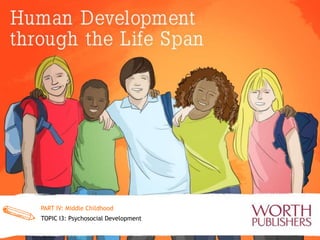
Review lecture 13 chapter 13
- 1. PART IV: Middle Childhood TOPIC I3: Psychosocial Development
- 2. 2 1. Introduction 2. Fact or Fiction? 3. The Nature of the Child 4. Families and Children 5. The Peer Group 6. Closing Thoughts PART IV: MIDDLE CHILDHOOD TOPIC 13: Psychosocial Development
- 3. 3 Fact or Fiction? Fiction Fact 1. School-age children typically are more self-critical than they were when they were younger. 2. Children in a shared home environment tend to react to family situations in a similar way. 3. Acceptance by their peer group is more important to school-age children than having a few close friends. 4. Bullying during middle childhood seems to be universal. Socioemotional Development PART IV: Middle Childhood TOPIC 13: Psychosocial Development
- 4. Psychoanalytic Theory How do children ages 6 to 11 enact the theories of Erikson and Freud? 4 Girls stay away! Boys stink. PART IV: Middle Childhood TOPIC 13: Psychosocial Development
- 5. Self-Concept What factors affect how children perceive themselves in middle childhood? Social comparison The tendency to assess one’s abilities, achievements, social status, and other attributes by measuring them against those of other people, especially one’s peers. PART IV: Middle Childhood TOPIC 13: Psychosocial Development
- 6. Coping and Overcoming 6 resilience: The capacity to adapt well to significant adversity and to overcome serious stress. What are some accumulated stresses that children experience? Source:SurveydatagatheredbyHowardJ.Osofskyetal.,of LouisianaStateUniversity;reportedinViadero,2007,p.7. Stresses Experienced by New Orleans Children as a Result of Hurricane Katrina Had been separated from a primary caregiver Had homes damaged in the storm Had moved Had transferred to a new school Had lost a family member or friend Had a parent who was unemployed Had been separated from a pet 10 20 30 40 50 60 70Percent PART IV: Middle Childhood TOPIC 13: Psychosocial Development
- 7. Coping and Overcoming 7 Video: Excerpts from Up Documentary: Paul and Simon, Two Children Who Lived in a Group Home PART IV: Middle Childhood TOPIC 13: Psychosocial Development
- 8. Shared and Nonshared environment 8 What are some parent-driven and individual-driven influences on siblings in a family? Shared parent influences Nonshared individual influences moves job changes for parent(s) divorce family’s socioeconomic status age genes resilience gender school and afterschool activities neighborhood peers PART IV: Middle Childhood TOPIC 13: Psychosocial Development
- 9. Material necessities Learning Self-respect Peer relationships Harmony and stability Family Function and Dysfunction 9 What do children age 6 to 11 need from their families? family function: The way a family works to meet the needs of its members. family structure: The legal and genetic relationships among relatives living in the same home. Although children eat, dress, and sleep without help, families can furnish food, clothing, and shelter Families can support, encourage, and guide education Because children become self-critical and socially aware, families can provide opportunities for success Families can welcome friendships Families can provide protective, predictable routines PART IV: Middle Childhood TOPIC 13: Psychosocial Development
- 10. 10 Family Trouble Low-income, high conflict Financial stress increases conflict and vice versa, affecting family function and structure The effects of poverty are cumulative Low SES may be especially damaging to children ages 6 to 11 High-income, high conflict Parental pressure on the children to excel causes stress in middle childhood This may lead to children’s drug use, delinquency, and poor academic performance in high school The Weight of Family Conflict PART IV: Middle Childhood TOPIC 13: Psychosocial Development
- 11. 11 The Culture of Children culture of children: The particular habits, styles, and values that reflect the set of rules and rituals that characterize children as distinct from adult society. What are some factors that shape a culture of children? Friendship and social acceptance Children learn how to be a good friend. Gender differences persist in activities. Boys and girls want best friends. Friends chosen for common interests, values, backgrounds. Popular and unpopular children aggressive-rejected children are disliked because they are antagonistic and confrontational. Withdrawn-rejected children are disliked because they are timid and anxious. Social awareness Social cognition is the ability to understand social interactions, including the causes and consequences of human behavior. Culture of Children PART IV: Middle Childhood TOPIC 13: Psychosocial Development
- 12. 12 Choosing friends Video: Social Development in Childhood: Developmental Trends in Children’s Conception of Friendship PART IV: Middle Childhood TOPIC 13: Psychosocial Development
- 13. Friendship is a symmetrical, one-to-one relationship. Popularity is a group concern. Social Acceptance Does being popular relate to being personally liked for girls in grade school and middle school? 5 7 9 70 60 50 40 30 20 10 Relationship between being liked and being thought popular 13 Grade PART IV: Middle Childhood TOPIC 13: Psychosocial Development
- 14. Bullies and Victims bullying: Repeated, systematic efforts to inflict harm through physical, verbal, or social attack on a weaker person. bully-victim: Someone who attacks others and who is attacked as well. What are some possible long-term consequences? PART IV: Middle Childhood TOPIC 13: Psychosocial Development
- 15. Bullies and Victims 15 Video: Girls Bullying Girls PART IV: Middle Childhood TOPIC 13: Psychosocial Development
- 16. Children’s Moral Codes 16 How did 133 9-year-olds respond to a moral dilemma? Repair Harm or Hurt the Transgressor? Percent Who Chose to Repair Harm Average Scores (Maximum 3) on Broken Window Plus Two New Stories 100 90 80 70 60 50 40 30 20 10 0 At first An hour later Two weeks later Eight weeks later Percent Score At first An hour later Two weeks later Eight weeks later 2.9 2.7 2.5 2.3 2.1 1.9 1.7 1.5 Boy-boy Girl-girl Mixed sex No interaction Source:Leman&Björnberg,2010. Source:Leman%Björnberg,2010. PART IV: Middle Childhood TOPIC 13: Psychosocial Development
- 17. Children’s Moral Codes 17 Video: Interview with Lawrence Walker PART IV: Middle Childhood TOPIC 13: Psychosocial Development
- 18. 18 In what ways do children build their social competence/skills during middle childhood? Closing Thoughts PART IV: Middle Childhood TOPIC 13: Psychosocial Development
- 19. PART IV: Middle Childhood TOPIC I3: Psychosocial Development
